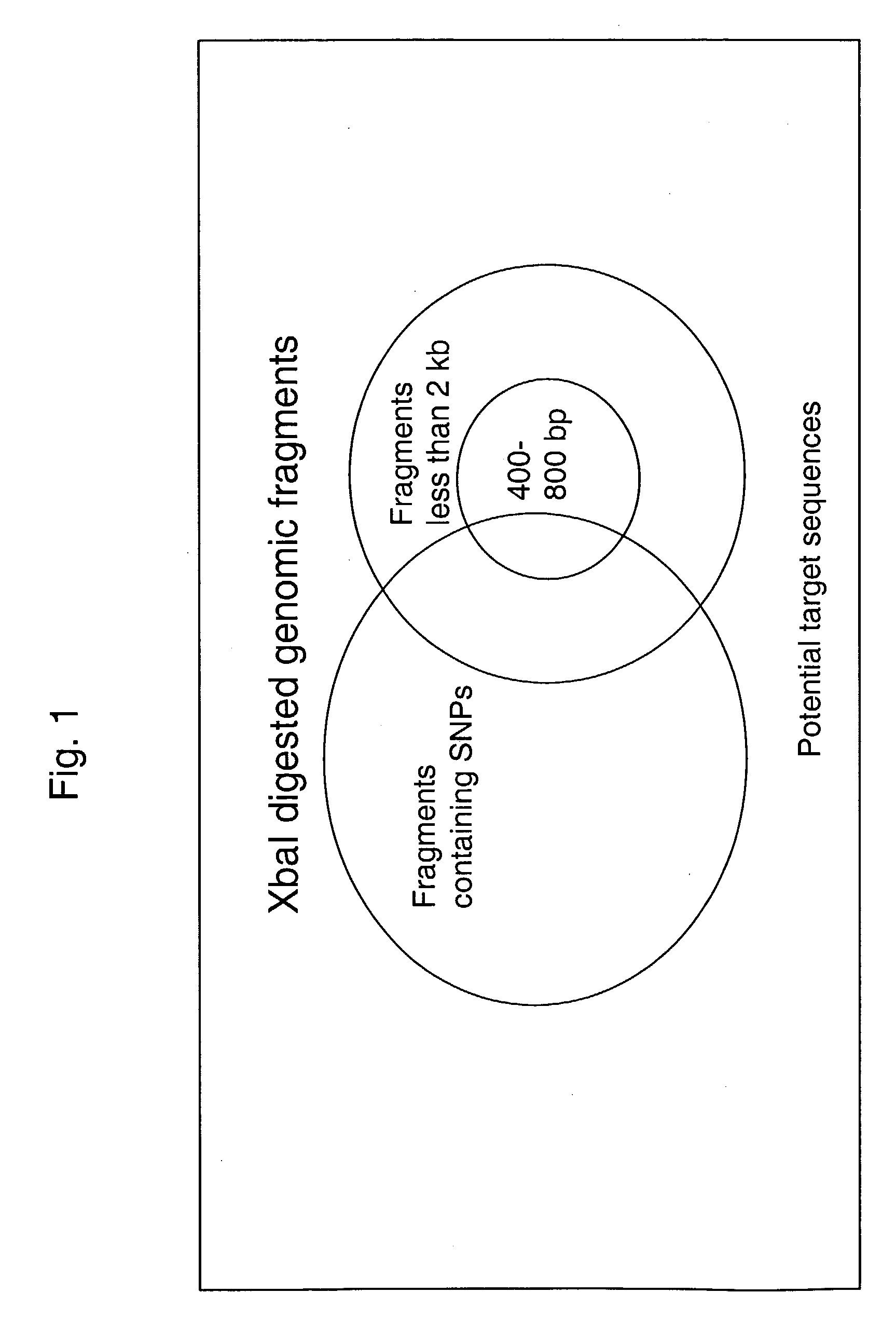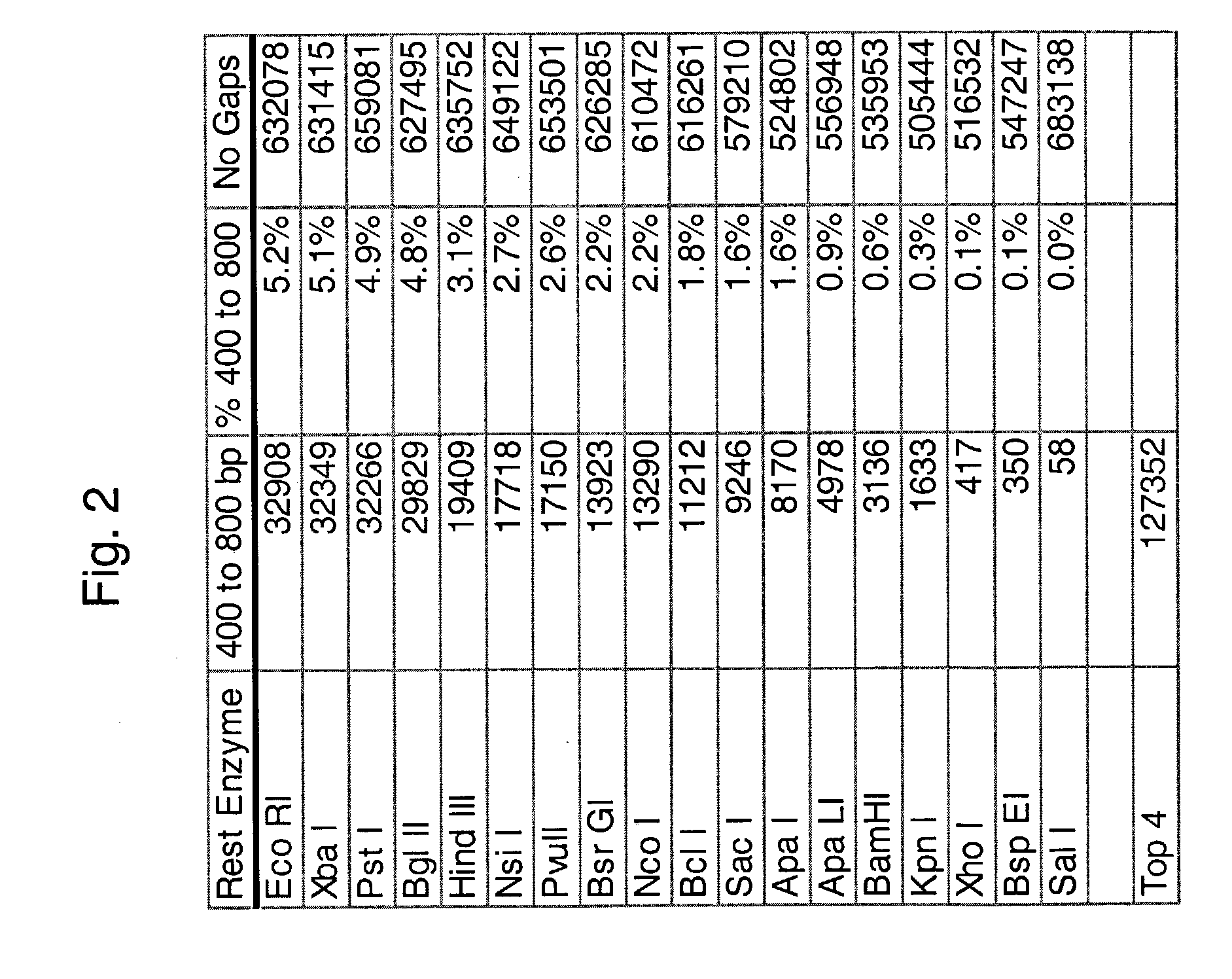Methods for genotyping
a genotyping and method technology, applied in the field of molecular biology and genetics, can solve problems such as the complexity of genomes, and achieve the effect of reducing the complexity of a first nucleic acid sampl
- Summary
- Abstract
- Description
- Claims
- Application Information
AI Technical Summary
Benefits of technology
Problems solved by technology
Method used
Image
Examples
example 1
[0174] Digestion: Digest 300 ng human genomic in a 20 μl reaction in 1× NEB buffer 2 with 1× BSA and 1 U / μl Xba1 (NEB). Incubate the reaction at 37° C. overnight or for 16 hours. Heat inactivate the enzyme at 70° C. for 20 minutes.
[0175] Ligation: Mix the 20 μl digested DNA with 1.25 μl of 5 μM adaptor, 2.5 μl 10× ligation buffer and 1.25 μl 400 U / μl ligase. The final concentrations are 12 ng / μl DNA, 0.25 μM adaptor, 1× buffer and 20 U / μl ligase. Incubate at 16° C. overnight. Heat inactivate enzyme at 70° C. for 20 minutes. Sample may be stored at −20° C.
[0176] Amplification: Mix the 25 μl ligation reaction in a 1000 ul PCR reaction. Final concentrations of reagents are as follows: 1× PCR buffer, 250 μM dNTPs, 2.5 mM MgCl2, 0.5 μM primer, 0.3 ng / μl ligated DNA, and 0.1 U / μl Taq Gold. The reaction is divided into 10 tubes of 100 μl each prior to PCR.
[0177] Reaction cycles are as follows: 95° C. for 10 minutes; 20 cycles of 95° for 20 seconds, 58° C. for 15 seconds and 72° C. for 1...
example 2
[0180] Genomic DNA was digested with XbaI by mixing 5 μl 50 ng / μl human genomic DNA (Coriell Cell Repositories) with 10.5 μl H20 (Accugene), 2 μl 10× RE buffer 2 (NEB, Beverly, Mass.), 2 μl 10× BSA (NEB, Beverly, Mass.), and 0.5 μl XbaI (NEB, Beverly, Mass.). The reaction was incubated at 30° C. for 2 hours, then the enzyme was inactivated by incubation at 70° C. for 20 min and then to 4° C. The reaction may be stored at −20° C.
[0181] For ligation of the adapters the digested DNA was then mixed with 1.25 μl 5 uM adaptor in TE pH 8.0, 2.5 μl T4 DNA ligation buffer and 1.25 μl T4 DNA Ligase (NEB, Beverly, Mass.) which is added last. The reaction was incubated at 16° C. for 2 hours then at 70° C. for 20 min and then to 4° C. The 25 μl ligation mixture is then diluted with 75 μl H20 and may be stored at −20° C.
[0182] For PCR 10 μl of the diluted ligated DNA is mixed with 10 μl PCR buffer II (Perkin Elmer, Boston, Mass.), 10 μl 2.5 mM dNTP (PanVera Takara, Madison, Wis.), 10 μl 25 mM M...
PUM
| Property | Measurement | Unit |
|---|---|---|
| Fraction | aaaaa | aaaaa |
| Fraction | aaaaa | aaaaa |
Abstract
Description
Claims
Application Information
 Login to View More
Login to View More - R&D
- Intellectual Property
- Life Sciences
- Materials
- Tech Scout
- Unparalleled Data Quality
- Higher Quality Content
- 60% Fewer Hallucinations
Browse by: Latest US Patents, China's latest patents, Technical Efficacy Thesaurus, Application Domain, Technology Topic, Popular Technical Reports.
© 2025 PatSnap. All rights reserved.Legal|Privacy policy|Modern Slavery Act Transparency Statement|Sitemap|About US| Contact US: help@patsnap.com



